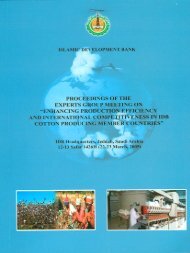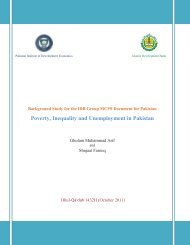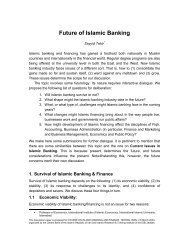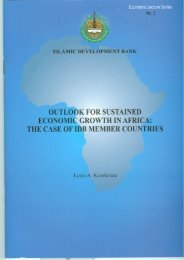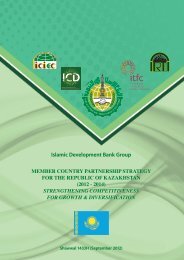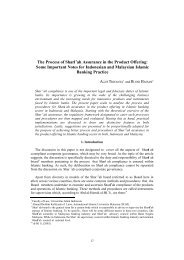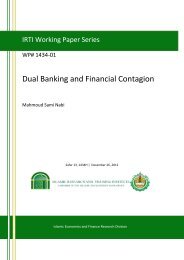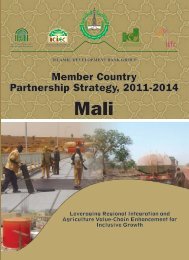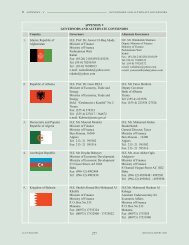Country Economic Work for Malaysia - Islamic Development Bank
Country Economic Work for Malaysia - Islamic Development Bank
Country Economic Work for Malaysia - Islamic Development Bank
You also want an ePaper? Increase the reach of your titles
YUMPU automatically turns print PDFs into web optimized ePapers that Google loves.
EXECUTIVE SUMMARY<br />
The main objective of this <strong>Country</strong> <strong>Economic</strong> <strong>Work</strong> (CEW) is to provide analytical basis <strong>for</strong><br />
designing IDB Group Member <strong>Country</strong> Partnership Strategy (MCPS) <strong>for</strong> <strong>Malaysia</strong>. This CEW is<br />
prepared by the IDB Group MCPS Team based on available in<strong>for</strong>mation and data from reliable<br />
national and international sources; two background studies prepared by the local Consultants;<br />
bilateral meetings with the key stakeholders; and outcome of two Consultative <strong>Work</strong>shops<br />
(attended by the public sector, private sector, academia, civil society etc.) held in <strong>Malaysia</strong>.<br />
The growth story that has trans<strong>for</strong>med <strong>Malaysia</strong> to be an upper-middle income country can be<br />
divided into two main phases: First phase, high economic growth during 1967-1997 when<br />
<strong>Malaysia</strong> (as one of 13 countries in the world) sustained growth of more than 7% per annum. The<br />
main driver of economic growth was surging domestic private investment rate at 26.9% of GDP<br />
accompanied by supportive public investment rate of 12.4% of GDP during 1990-1997 1 . Second<br />
phase: (post-Asian financial crisis) relatively slow economic growth during 2000-2011 of<br />
average 5% per annum was mainly due to perceptible drop in domestic private investment rate at<br />
10.5% of GDP per annum while public investment per<strong>for</strong>med countercyclical role to partly offset<br />
the slowdown in private investment. In terms of sectoral per<strong>for</strong>mance, the services sector<br />
remained the main source of economic growth. In 2009, the manufacturing sector was hit hard<br />
with negative growth of 9.3% on account of global recession but recovered remarkably with a<br />
positive growth of 11.4% in 2010. Compared to other key sectors, growth in the agriculture sector<br />
remained relatively slow. During 2000s, the agriculture sector grew by 3.2% per annum.<br />
Other macroeconomic indicators also showed sound per<strong>for</strong>mance of the economy. For example,<br />
the average current account surplus remained 12.8% of GDP and trade surplus 16.9% of GDP per<br />
annum during 2000-2011, significantly high compared to other competitive countries in the Asian<br />
region. Inflation remained at the modest level (average 2.2% per annum during 2000-2011).<br />
<strong>Bank</strong>ing sector is built on solid foundations, with strong capital adequacy and a considerable<br />
amount of excess liquidity (surplus liquidity of MYR255 billion or $82.6 billion in 2011).<br />
However, federal budget deficit remained average 5% of GDP during 2000-2011 but currently<br />
fiscal consolidation is underway.<br />
In addition to the remarkable progress in macroeconomic indicators, <strong>Malaysia</strong> has steadily<br />
improved its human development indicators and has been considered as a high human<br />
development country (HDI ranking 61 out of 169 countries in 2011). The country has also made<br />
remarkable achievement in reducing poverty (from 49.3% in 1970 to 3.8% in 2009), and the<br />
economy remains almost at full employment level (i.e. unemployment rate 3.1% in 2011).<br />
Using a comprehensive Growth Diagnostic Framework, which was developed by the MCPS<br />
Team (an extended version of Growth Diagnostic Framework of Hausmann, Rodrik, and Velasco<br />
1 <strong>Malaysia</strong>n National Accounts and the World <strong>Bank</strong>, World <strong>Development</strong> Indicators do not provide data on private<br />
investment prior to 1990.<br />
1







